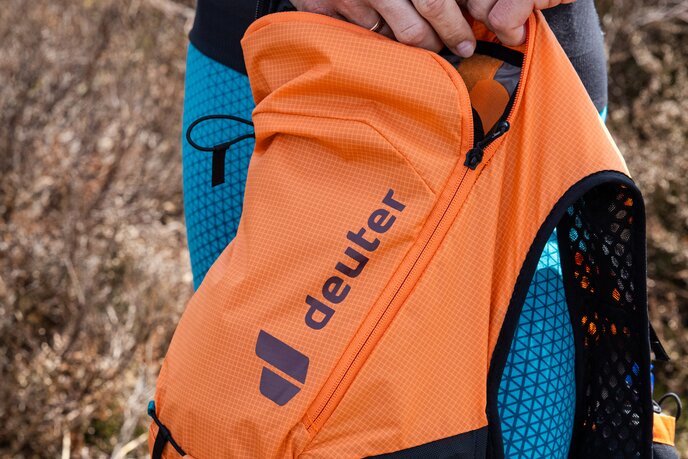Careful planning
Planning is essential for having a good trail running experience. And it’s a good idea to stick to an established routine for this: from targeted training to route selection and checking the weather or safety measures on the trail. This will help you avoid any nasty surprises and minimize risks — both for you and others. We’ve compiled the most important elements for planning a trail run.
DIE 3X3-METHODE FÜR TRAIL RUNNING TOUREN
Using the 3x3 model, you will look at each of the three factors:
- Planning from home
- Localized assessment, just before the start of the tour
- Regular checks of conditions and the group during the run
And then three further variables come into play:
- PEOPLE: fitness levels, technical ability, schedule, group size, responsibilities within the group, group members’ expectations
- EQUIPMENT: appropriate gear for the activity, packing lists, first aid tips
- CONDITIONS: weather forecast, actual weather conditions, season, trail conditions, crux sections, type of run, nature preservation, planning & navigation
This will help rule out many potential issues or nasty surprises. And if things still don’t quite go to plan, you’ll be better prepared to deal with it.
At first, the 3x3 model may seem a little abstract. But in practice, it’s a really useful tool. It’s an effective and comprehensive way to systematically prepare for your trail runs.
Important rules of conduct for a harmonious cooperation on the trail
- Waiting: at forks in the trail and when the group becomes too spread out, those at the front should wait for those at the back. Don’t set off again as soon as the last one catches up. Even though the ones in front may have waited already 15-30 minutes and are fully rested, the ones at the back of the group are in just as much need of a rest, if not more!
- Remember that taking fewer longer rest breaks is better than several short breaks. Short breaks disrupt your running/walking rhythm and don’t usually result in any lasting recovery benefits.
- If some of the weaker members of the team are repeatedly stopping for short breaks to rest, they should slow their pace.
- Take time to regularly check your trail buddies (steadiness, breathing, coloring in the face, sweat levels, in winter signs of hypothermia) and look out for signs of exhaustion.
- In higher-risk sections of trail (e.g. old snow fields across exposed alpine terrain) discuss how you’re going to negotiate it with the whole group. Then pass through the dangerous sections, one at a time.
- In thick fog, during a night run or on a more severe alpine route it’s best to divide the group up into pairs and have a buddy system.
- Trail buddies keep tabs on changes in each other’s health, such as exhaustion, dehydration, low blood sugars or hypothermia – symptoms which often go unnoticed by those experiencing them – and can raise the alarm if somebody goes missing in the dark or fog.
TIP
If you want to find out more about trail running best practice there’s a detailed overview of the general mountain code of conduct here.
Group checklist
• How long do I want to run?
• What’s the ability level of the group? Does it vary or is it pretty similar?
• Do we have the right level of fitness, stamina, and running technique for the planned route? What kind of training is necessary?
• What kind of trails do I want to run on?
• What kind of difficulties can I cope with? Am I sure-footed, can I negotiate short scrambling sections? Am I scared of heights?
• What does the average pace need to be?
• Do I need longer rest breaks? Have we scheduled in breaks like that?
• Am I prepared to drop back and help any struggling group members?
• Agree on the expectations of the group once again
• Discuss the schedule and route
• Discuss crux sections and possible weather-related changes to the plan
• Are all group members healthy? Is there someone in the group who is less fit than expected? How can any differences in fitness and running technique be reasonably balanced out in the group?
• Are the difficult sections (uphill & downhill) on the route appropriate for the actual running technique and fitness level of the group?
• Regularly check motivation levels and mood within the group and react accordingly
• How about energy reserves? Are any of the group showing signs of exhaustion or having difficulty concentrating? Does anyone have cramp? (magnesium tablets)
• Dehydration and hunger pangs: on longer runs, check that everyone is drinking fluids regularly and eating appropriately (intervals depending on weather conditions and pace)
• Is the level of difficulty of the trail appropriate for the group? What are the potential consequences? Is a change of route called for?
• Are extra rest breaks needed?
• How can the stronger members of the group support the weaker ones?
Running technique checklist
• Check your fitness, stamina and running technique are up to the planned route
• Practice your running technique, specifically for the level of difficulty or terrain you can expect on the route
• Train for fitness, bearing in mind the length of the route and height gain you can expect
• Or book onto a trail running technique course
• Check that all group members have sufficient levels of running technique and experience
• Check that all group members are fit enough for the route
• How can group members with varying performance levels best work together?
• Check the difficult route sections (uphill & downhill) are well matched with the running technique and fitness levels of the group?
• What are the possible consequences? Is a change of route called for?
• Should the group split up for some of the sections?
• How can the stronger group members support the weaker ones?
Basic tips for trail runners
- Start slow. You’ll settle into the right speed automatically. Prevent overstraining by steadily increasing the intensity and distances covered during training. As a guideline, 10% increase per week works well.
- Work on your running technique: good coordination is particularly important when you’re running off-road. Taking a guide or trainer with you occasionally is a good idea. After all, fixing any bad habits is much harder once they’re ingrained. And you’ll avoid putting undue strain on your body, which can lead to pain or even injury in the long run.
- Invest in good gear. It might seem obvious, but having shoes with good grip and cushioning makes such a difference! Insoles that are molded to your foot will give you better support too. Using a backpack or vest that’s built for trail running will keep your gear nice and compact against your body.
- Take your time: the condition of the trail and the weather will dictate your pace. Distance and speed are less relevant off-road. Running 10 km through tough mountain terrain can often take twice as long as it would running 10 km on roads.
- Hone your reflexes: train responsiveness, coordination, stability, and balance so that you can master the challenges of off-road terrain.
- Stretch regularly and recover sufficiently: warm up, stretch, and don’t forget to warm down. Get enough sleep and eat a nutritious diet. Take time to recover adequately.
- Watch for signs of fatigue: when energy levels, concentration or coordination start to drop, you’re at increased risk of injury. Slow the pace and walk some sections. And make sure you take in plenty of fluids and calories.
- Keep motivating one another: ideally have a training buddy to spur you on. It’s more fun running with others, and you can help each other with feedback and support.
FAZIT
Being in tune with your body and with the needs of others is not only good practice in life, but in trail running too. There’s little point in trying to achieve too much in too short a period. The key is to slowly, steadily adjust to the demands of running in the mountains.
Master the ups and downs with the correct technique

Master the ups and downs with the correct technique
HOW DO I GET UP THE MOUNTAIN?
With good running technique, long challenging uphills and downhills are much less daunting. So work on your technique. Keep your heart rate low to allow you to fully focus on your technique. Stay loose and relaxed.
Here are six basic tips on how to run up mountains efficiently and without too much effort, so you still have enough energy to enjoy the spectacular mountain scenery at the top.
Correct technique for optimum uphill running
Uphill technique – stay loose
- Stay upright and keep your back straight. Don’t lean too far forward, i.e. don’t tilt your upper body forward from the hips, and don’t hang your head. Your center of gravity should be just ahead of your feet.
- Low ratios: just like with biking, using a lower gear saves energy. So take smaller steps and increase the frequency.
- Active arms: consciously use your arms and coordinate them with your legs. Your arms should swing in line with the direction you’re running and remain close by your sides. When your arms swing back, your upper arm, forearm and torso should create what’s known as the ‘runner’s triangle. This helps your upward propulsion.
- Run on your forefoot: imagine the front of your foot is a coiled spring that catapults you forward with each step.
- Eyes forward: don’t look at your feet. Instead, keep your gaze a couple of meters ahead. Scan the terrain so your body and mind are prepared for what’s coming.
- Walking isn’t cheating: in fact, for especially steep ascents it’s actually more efficient. Switch to speed hiking mode and push off the ground in powerful strides. It’ll save energy and you’ll barely be any slower than if you were running. Poles will give you an extra turbo boost. They take some of the strain off your legs. Without poles, you can prop yourself up on your thighs for support, just above the knee.
- Find your own rhythm. Whether you’re running or walking, try to stick to a regular rhythm. Changing pace uses up energy and will impact your stamina.
HOW CAN I OPTIMIZE MY DOWNHILL TECHNIQUE?
Downhill is justifiably regarded as the ultimate trail running discipline. It’s good to have a healthy respect for technically demanding downhill sections, but there’s no room for fear. Keep moving and stay focused. And you’ll get to the bottom safely and efficiently.
Downhill running has its downsides. But with our pro tips, you’ll soon get to the bottom safely.
Correct technique for optimum downhill running
Downhill technique – full focus
- Stay upright: engage your core but don’t tense up. Shift your center of gravity slightly more forward. Tensing up too much can increase the chances of wrong footing. Similar to skiing: don’t lean back or you’ll lose control.
- Eyes forward: don’t look at your feet. Instead, keep your gaze a few meters ahead. Scan the terrain coming up, from left to right. Find a line and stick to it.
- Keep your steps small: run downhill in short, quick steps so that you can react more quickly. It also cuts down the risk of slipping, especially on scree or wet ground. Try to keep your knees ‘soft’ and supple and keep them slightly bent.
- Keep ground contact to a minimum, as if you were running over hot coals.
- Strike the ground with your forefoot: this will give you more precise foot placement and prevent you twisting your ankle. (Exception: on scree & snow/old snow roll off from the heel)
- Your arms can swing out wider than when you’re running on tarmac, for added balance and stability.
- ry to avoid braking hard: reduce your speed in a more controlled way, not suddenly. Abrupt braking can easily lead to skidding. On steep, sloping terrain, feel free to make the occasional switchback.
TIP
Take it slowly. Find a stretch of trail on which to specifically train downhill technique for a period of 15 minutes. Start with an easier section and run downhill for 30- to 45-second intervals. In between, you can walk. Increase the training gradually and in a controlled way over several weeks. Choose increasingly challenging terrain. This will help build confidence and technical ability.
Extra boost – trail running with poles
Poles, or no poles? As a trail runner, you’ve probably already pondered this fundamental question. The longer, steeper, and more technical the trail, the more of an extra boost, propulsion and energy saving poles can provide – provided you use them correctly! After all...running with poles is something that requires good coordination or synchronization, and that’s something that needs to be practiced.
Using poles eases the strain on the calf and thigh muscles and spreads it across the muscles in the back, arms, and shoulders. This reduces the strain on your leg muscles. Which makes it easier to build up speed and maintain that pace over longer distances. And ultimately it increases your endurance.
How to use poles correctly
Poling techniques for uphill
Depending on the terrain and speed, running poles can be used in three different ways:
Double-poling method – or mountain gear
This technique is particularly good for very steep ascents or for when you have heavy legs. It’s also good for loose ground (scree/gravel).
- Plant both poles at the same time, just ahead of you
- Push off hard from them, to propel your body forward, and do this every three steps.
Diagonal/alternating method – acceleration
This technique is often used to build up speed quickly, over a short distance. It’s most effective over solid ground. This technique is less suited to longer trails because it uses a lot of energy.
- Plant your poles in time with the opposite foot as it strikes the ground, similar to cross-country skiing, i.e. right foot and left pole, then left foot and right pole etc.
Gallop method – energy saving
The gallop technique is ideal for moderate speeds and moderate inclines. This method is good for saving energy.
- Plant your right pole at the same time as your right foot.
- Then take two steps without poles. Before planting your left pole in time with your left foot.
Poling techniques for downhill
Using poles to run downhill requires plenty of practice, experience, and especially high levels of coordination and concentration. Otherwise poles can be a dangerous trip hazard.
You can use your poles on easier downhill sections. For example, when your legs are tired and need a little relief. And it also relieves the strain on your joints. But often, when it comes to downhill running, it can be safer, and even quicker, to keep your hands free and use your arms for balance. This is especially true for technically demanding sections of trail. In general, using poles should not impair your technique or safety.
TIP
Less experienced runners should start off with their hands out of the wrist loops and slowly ease into the technique.
How do I adjust my backpack or vest correctly?
With trail running you’re moving fast, and in an up-and-down direction. That’s why it’s so important a backpack fits like a second skin and has good cinching options so that it stays compact and allows full freedom of movement. This is particularly important seeing as your ribcage needs plenty of room to expand and contract when you’re running.
ADJUSTING THE BACKPACK CORRECTLY

The right model
Which model of backpack is right for you, is largely down to what kind of trail running you’ll be doing. Or more precisely:
- Duration: how long will I be running?
- Type of run: where am I going/ how remote will it be?
- Weather or season: what will weather conditions be like? What do I need to pack?
While a running belt is big enough for a post-work run around your local lake, you’ll need a bigger backpack or a vest for ultra distances through the mountains, to fit everything you need into it. For races there’s a long list of compulsory equipment you have to take.
You can find running backpacks and vests in different sizes and with a range of features to suit your trail running adventures here.
You’ll find detailed information on each trail running pack here.

How should I pack my running pack?
The basic principles
Keep it as light as possible, but with everything you need. Every gram counts when you’re on the trail. So carefully consider each individual item you take. Once you’ve packed all the essentials, think about anything you might also want with you, for your personal needs and usual habits. Take only what you need and, where possible, trim down the weight of each individual item you take.
Optimum weight distribution
Pack your backpack so that the heaviest items are in the middle of the pack and close to your back. This will help with balance and be more comfortable to carry. If your pack has compression straps, use these to compress the volume of the pack and keep the load more snug against your body.
How should I pack my running pack?
Less really is more! Find out how to optimize the weight of your stuff, where to pack it. Plus what else you might consider taking – in this video and here on our packing lists page.
How should I pack my running pack?


First aid for trail running
First aid practices are not necessarily intuitive, they require regular practice. You should have regular refreshers on the basics of first aid. Ideally by taking a course. Or at the very least familiarize yourself online with the most important aspects of first aid. You can find an emergency first aid guide here. And a first aid kit with survival blanket should always be part of your standard equipment. Plus a list of key telephone numbers, like huts along the route and local emergency services:
Mountain emergency numbers
Germany |
112 |
Austria (mountain rescue) |
140 (Vorarlberg 144) |
Switzerland (Rega) |
+41 333 333 333 (with a Swiss phone 1414) |
South Tyrol |
112 |
Europe |
112 |
UK |
999 |
Canada/ USA |
911 |
Tip
With the new free SOS EU Alp app you can make an emergency call quickly and easily, which is transferred to the relevant rescue coordination center along with your location data (GPS coordinates) and contact details (direct telephone number).
What to bear in mind when planning a trail run?
Being realistic in your self-assessment will prevent you from getting into trouble on your trail run. In this video, we’ll offer some helpful tips for emergencies, and some safety questions you should address before each run.
TOUR PLANNING TIPS FROM NATALIA

TOUR PLANNING
Get hold of a detailed hiking map and work out a route. You can usually find any relevant descriptions in hiking or biking guidebooks for the area in question. Pay particular attention to information on trail conditions and possible crux points such as mountain passes, steep gullies, sections where there is a fall hazard, etc.
Detailed maps with a scale of 1:25,000, 1:20,000 or even better 1:10,000 are perfect for route planning – provided you can read maps. Many areas even provide detailed maps for free. Simply drop by the tourist office or local town hall.
Tip: Be realistic with your planning, work in rest breaks – especially when you’re running in a group.
Digital representations of hiking or mountain biking routes are a good starting point for planning a trail running route. Naturally, you need to make sure that you adapt the route length and difficulty to suit your fitness level and running technique – and those of your running companions.
Useful links for routes:
HOW-TO-FATMAP
Checklists, planning & navigation
• Select a suitable route
• Locate rest stops or mountain huts for breaks or as retreat options in case of an incident
• Establish alternative routes or retreat strategies for bad weather or unexpected incidents
• Check you have a map/GPS device
• Have you saved the route info to your cell phone? Batteries all charged?
• Is navigation becoming difficult?
• Do you need to change the planned routes (weather, level of difficulty etc.)?
• Any unexpected trail closures or restriction notices?
• What alternatives are there?




















